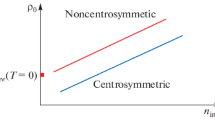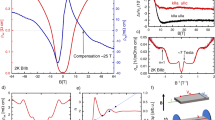Abstract
Using the phonon model of Nishiyama and Riegel for the electric field gradient we have investigated the possibility of an isotopic mass effect. We will show that there is an isotopic mass effect nearT=0 K. In this temperature region the electric field gradient depends on the probe atom mass only.
Similar content being viewed by others
References
R.S. Raghavan and P. Raghavan, Hyp. Int. 4(1978)1.
W. Keppner, W. Körner and G. Schatz, Proc. Sixth Int. Conf. on Hyperfine Interactions, Groningen, 1983, published in Hyp. Int. 15, 16(1983)203.
K. Nishiyama and D. Riegel, Hyp. Int. 4(1978)490.
P. Heubes, W. Keppner and G. Schatz, Hyp. Int. 7(1979)93.
D.W. Taylor, in:Dynamical Properties of Solids, ed. G.K. Horton and A.A. Maradudin, vol. 2 (North-Holland, Amsterdam, 1975) p. 285.
J.M. Grow, D.G. Howard, R.H. Nussbaum and M. Takeo, Phys. Rev. B17(1978)15.
H.J. Lipkin, Ann. of Phys. 23(1963)28.
Author information
Authors and Affiliations
Rights and permissions
About this article
Cite this article
Hermans, L., Van Cauteren, J. & Rots, M. On the electric field gradient in non-cubic metals: The isotopic mass effect. Hyperfine Interact 20, 169–172 (1984). https://doi.org/10.1007/BF02073560
Received:
Issue Date:
DOI: https://doi.org/10.1007/BF02073560




